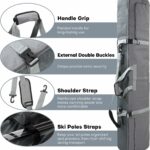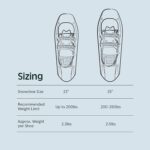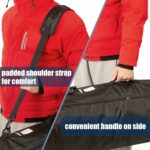You are about to embark on a detailed guide to handle a common but tricky task – getting those snowmobile handlebar grips off. You’ll learn some practical, efficient techniques that are not only safe but also make the task easier, even if you’re trying this for the first time. Evoking frustration amongst many, this task is not as daunting as it seems. So grab your gear, keep your focus, and let’s tackle this challenge head-on.
Understanding Your Snowmobile’s Handlebar Grips
Just like that trusty mug in your hand on a winter morning, the handlebar grips on your snowmobile play a crucial role in your comfort, control and overall ride experience. While it may seem a minor part of your snowmobile, understanding its function begins by first identifying it.
Basics of Snowmobile Handlebars
Snowmobile handlebars are designed to give you control over your sled. They help you steer and navigate through snowy terrain. The height, width, and even the material of the handlebars can influence how well you control your snowmobile.
Significance of Snowmobile Grips
Attached at the ends of the handlebars are the grips. The grips are incredibly important as they’re the interface between your hands and the sled. They help you hold on, steer, and work the throttle and brake. Therefore, they need to be comfortable and provide good traction even when wet or cold.
Common Reasons to Replace Handlebar Grips
Grips, due to constant use and exposure to harsh weather, wear out over time. Signs that it’s time to replace your grips include worn out patterns, cracks, or if they’ve become hard due to cold. A good grip can make a huge difference to your comfort and overall safety, so it’s important to keep them in top shape.
Tools You Will Need
Perhaps you’ve decided it’s time to replace those worn-out handlebar grips. Great! Let’s begin by gathering all the necessary tools.
List of Needed Instruments
Typically, you would need a few simple tools like a pair of pliers, a flat-head screwdriver, and a utility knife. Also, compressed air can be helpful, if available.
Safety Gears
Safety is paramount! Always wear gloves to protect your hands from sharp edges and safety glasses to protect your eyes from debris.
Selecting the Right Tools
Finding the right tools is all about effectiveness and safety. Make sure your tools are in good condition and are comfortable to use.
Preparing for the Removal
Just like in any mission, proper preparation is vital for success and safety.
Clearing the Workspace
Before you begin, clear your workspace. Make sure there’s ample lighting and all your tools are within reach.
Inspecting the Grips for Damage
Take a moment to inspect the grips. Look for tears, cuts, or areas where it’s worn out.
Ensuring Safety Precautions
Again, remember that safety comes first. Put on your gloves and safety goggles, and ensure the snowmobile is securely stationary.
Accessing the Handlebar Grip
Now that you’re ready, let’s get down to business.
Proper Positioning of the Snowmobile
Ensuring that your snowmobile is properly positioned is crucial. Make sure it’s on a level surface and it’s stable before you proceed.
Unhooking Brake Cables and Wires
Before you can access the grips, you need to unhook any brake cables or wires attached to the handlebars. Be careful not to pull too hard and damage them.
Unscrewing the Handlebar Ends
At this point, you can now unscrew the handlebar ends. Once done, get ready to start removing those old grips.
Loosening the Handlebar Grips
You’ve come a long way, buddy. Now it’s time to loosen those grip handles.
Cutting Technique for Rigid Grips
For rigid grips, the cutting technique is typically used. Carefully slide a utility knife under the grip and slowly work your way around the circumference.
Twisting and Rolling Method
For grips that aren’t overly rigid, you can try the twisting and rolling method. Hold the end of the grip and twist or roll it back and forth until it loosens.
Using Compressed Air for Removal
Alternatively, you can also use compressed air. Insert the nozzle underneath the grip and give it a quick burst. The air will break the seal and loosen the grip.
Removing the Handlebar Grips
All set? Let’s remove those worn-out grips now.
Pulling off the Grip Slowly
With the grip properly loosened, it’s time to pull it off. Take your time and pull it off slowly to avoid snapping it.
Method of Using a Screwdriver
Alternatively, you can also use a screwdriver. Insert it between the grip and the handlebar and gently twist it around to loosen until the grip slides off.
Using a Blow Dryer to Ease Removal
Sometimes, a blow dryer might come in handy. The heat from a blow dryer can soften grip rubber, making it easier to slide off.
Handling Stubborn Grips
If your grips are putting up a fight, don’t fret!
Why Some Grips are Difficult to Remove
Some grips can be stubborn due to the glue used or simply because they’ve been on the handlebars for a long time.
Using WD-40 or Heat for Stuck Grips
WD-40 spray can be your savior in such cases. Heat can also be a great helping hand to loosen the glue or hardened rubber.
Carefully Cutting the Grip if Necessary
When all else fails, gently and carefully cut through the grip. But watch out not to damage the handlebars.
Cleaning the Handlebars Post Removal
You’ve successfully removed the grips, great job! But our mission’s not yet over.
Why Cleaning is Necessary
Cleaning the handlebars post removal is critical to ensure a proper fit of new grips.
How to Properly Clean the Handlebars
Brush off any old glue or debris, and wipe the bars clean with a damp cloth.
Ensuring No Residual Glue or Debris
Ensure there’s no residual glue or debris that could interfere with the new grip installation.
Handling Potential Complications
Sometimes, things might not go as smoothly. It’s good to be prepared.
Damaged Handlebars During Removal
If the handlebars get damaged during removal, don’t panic. Small scratches can be smoothed out or filled. But if they are significantly damaged, you might need to replace them.
Unexpected Handlebar Issues
If you come across unexpected issues like rust or any other damage to the handlebars, it might be time for a replacement.
Getting Professional Help
Don’t hesitate to get professional help if needed. No shame in turning to people who do this for a living.
Replacement Process of the Handlebar Grips
With the old grips off and handlebars clean, it’s time to put on the new grips.
Choosing the Right Grip for Your Snowmobile
Choosing the right grip is important. Find ones that not only fit your handlebars but are also comfortable and provide a good grip.
The Proper Way to Install Handlebar Grips
Slide the new grip onto the handlebar. You might need to use a lubricant like soapy water to make it easier. Once on, let them dry completely before use.
Safety Check Post Installation
After installation, be sure to conduct a safety check. Make sure the grips are secure and don’t twist while using.
Congratulations, you’ve successfully replaced the handlebar grips on your snowmobile! With your newfound knowledge and skills, you can now enjoy a more comfortable—and safer—ride on the snow!
- What Snowboard Bindings Should I Get? - January 23, 2024
- What Size Screws For Snowboard Bindings? - January 23, 2024
- How To Snowmobile On Water? - January 23, 2024










